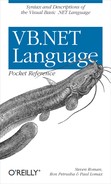Visual Basic Conventions
The “rules” for Visual Basic (VB) code are very simple:
VB is a case-insensitive programming language; that is, the compiler ignores case when reading VB code. So
myVar,MyVar,MYvar, andMYVARall refer to the same variable. Note that Visual Studio imposes a uniform casing on all language elements, although this is not a requirement of the compiler.White space (except for line breaks) is ignored when reading VB code.
Line breaks mark the end of a complete statement; complete VB statements must occupy a single line.
If you want to break a single statement over several lines, you can use the line continuation character, an underscore (_), which must be preceded by a space and must be the last character on the line that is to be continued.
If you want to combine multiple statements on a single line, you can use the colon (:). Among other uses, it is commonly used to imitate C++ and C# syntax for inheritance. For example, the code fragment:
Public Class MainForm Inherits Form
can be shortened as follows:
Public Class MainForm : Inherits Form
Two comment symbols are used: the apostrophe (
') and theRemkeyword. They may appear at any place within a line.
